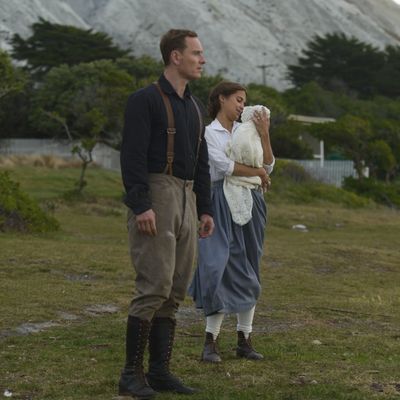
Derek Cianfrance, the director of the romantic weeper The Light Between Oceans, is so eager to get to his main setting — a remote, cliff-side West Australian lighthouse battered by storms and swells — that he puts thunder, crashing waves, and seagull cries over the various studio and production company logos. It’s a bit jarring when the first scene turns out to be set in an office on dry land, where the film’s protagonist, Tom Sherbourne (Michael Fassbender), a traumatized World War I vet, is being interviewed for the lonely job of lighthouse keeper. But Cianfrance shoots the entire movie as if the surf were in his ears and a storm bearing down. As my old Dickens professor would say, the roiling waves are an objective correlative for the characters’ roiling insides. There’s a whole lotta roiling going on.
It takes Cianfrance half an hour to get to where the novel by M.L. Stedman opens: Sherbourne’s young wife, Isabel Graysmark (Alicia Vikander), is sitting on the rocks near the lighthouse, hundreds of miles from any town, when a baby in a boat comes bobbing in on the waves. This is extraordinarily fortuitous, given that she has had a series of miscarriages (the first in a ferocious storm that leaves her pounding vainly on the lighthouse door as the rain sheets down) and has given up hope of having a child. The Lord giveth, the Lord taketh away, the Lord giveth back. The question is whether the Lord will taketh away again, seeing as how He tends to be a bit of a tease. Next to the baby in the boat is a dead man, which means there’s a backstory here and maybe a mother with a claim on the baby. But what are the odds of ever seeing her — especially when Isabel, hugging the child (a girl), pleads with Thomas to bury the man and raise the baby as their own?
The Light Between Oceans works you over but good. When the action shifts to towns and railway stations, limbless men hobble by, maimed by a war that took so much so inexplicably. Thomas cannot see the gain of a child in a vacuum. He wants to take away his wife’s case of the sads. But what if this leads to someone else’s torment? On a trip to the village to have the baby baptized, he sees a woman in black weeping at a graveside at the very same instant he is asked to renounce the devil and all his works. He is between — well, two oceans. (The title is metaphorical and literal — the lighthouse is perched where two oceans meet.) (Isabel’s name, Graysmark, suggests that she will always carry the mark of sadness.) (Thomas’s name, Sherbourne, suggests a moral center that gales cannot dislodge.) (That’s all I got.)
Cianfrance has a visual style I can only call persistent. He jumps between wide vistas (waves, crags, screaming birds) and micro-close-ups, as if he wants to get beneath his characters’ skin. I thought this strategy worked well in his first feature, Blue Valentine, in which the married couple (Ryan Gosling and Michelle Williams) was barely hanging on, and every twitch and quiver could sway the story’s outcome. Here, the material is already melodramatic — the characters are at the mercy of seismic forces — and Cianfrance’s direction comes off as wildly overwrought. We don’t need to be that close. I felt relief that Vikander has one of the creamiest complexions in film (not a pore to be seen) and that Rachel Weisz — who plays the girl’s biological mother — is nearly as flawless, despite having a couple of decades on Vikander.
If you’re going to be on top of faces, these are good faces to be on top of. Vikander is an extraordinary actress, emotionally translucent — maybe even worthy of the hype. But however close the camera comes, Isabel is a difficult character to make sense of. Why does she glom onto the pallid Thomas so quickly? Why is she instantly giddy at the thought of traveling to such a forsaken place, hundreds of miles from anywhere? Much of the novel is from her point of view, but Cianfrance can’t help seeing her through Thomas’s eyes — as someone utterly irrational who needs to be saved.
Fassbender purges all traces of guile from his face and is visibly wracked: He makes you understand that, for Thomas, martyrdom would be preferable to keeping company with the devil. But he’s such a chameleon actor that when he’s passive, he has no personality. (Whenever I think back on him in this movie, the face that comes into my head is Ralph Fiennes’s.) Maybe the most startling performance is Weisz’s. It’s a thankless role — there’s no way to win the audience’s sympathy completely, even though the character, Hannah Roennfeldt (née Potts), is in the right. And that backstory (spoiler alert: her husband was German and apparently on the verge of being lynched when he jumped into a boat with the baby???!!!????) is a laugh riot. But Weisz acts with such simplicity (no tricks, no grandstanding) that she short-circuits the melodrama. She just is. (Weisz is wonderful in a much showier role in the new Complete Unknown, but the movie is dim and arty.)
If the last section of The Light Between Oceans reduces people to puddles, it’s for the same reason Blue Valentine did. On one side are flawed but noble grown-ups who can’t make happily-ever-after work; on the other is a small, innocent, intensely vulnerable child who is suddenly bereft. Stedman — a potboiler writer with pretensions — added a ridiculous coda to ease the reader’s mind and Cianfrance reproduces it. He can’t make it work, though. He’s not that shameless. The movie ends up seeming like an inchoate hybrid of melodrama and psychodrama — between the oceans, indeed.





